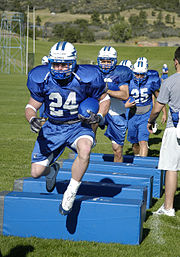Physicality

American football is a collision sport. To stop the offense from advancing the ball, the defense must tackle the player with the ball by knocking or pulling him down. As such, defensive players must use some form of physical contact to bring the ball-carrier to the ground, within certain rules and guidelines. Tacklers cannot kick or punch the runner. They also cannot grab the face mask of the runner's helmet or lead into a tackle with their own helmet. Despite these and other rules regarding unnecessary roughness, most other forms of tackling are legal. Blockers and defenders trying to evade them also have wide leeway in trying to force their opponents out of the way. Quarterbacks are regularly hit by defenders coming on full speed from outside the quarterback's field of vision. This is commonly known as a blindside.
To compensate for this, players must wear special protective equipment, such as a padded plastic helmet, shoulder pads, hip pads and knee pads. These protective pads were introduced decades ago and have improved ever since to help minimize lasting injury to players. An unintended consequence of all the safety equipment has resulted in increasing levels of violence in the game. Players may now hurl themselves at one another at high speeds without a significant chance of injury. The injuries that do result tend to be severe and often season or career-ending and sometimes fatal. In previous years with less padding, tackling more closely resembled tackles in Rugby football. Better helmets have allowed players to use their helmets as weapons. This form of tackling is particularly unwise, because of the great potential for brain or spinal injury. All this has caused the various leagues, especially the NFL, to implement a complicated series of penalties for various types of contact. Most recently, virtually any contact with the helmet of a defensive player on the quarterback, or any contact to the quarterback's head, is now a foul.
Despite protective equipment and rule changes to emphasize safety, injuries remain very common in football. It is increasingly rare, for example, for NFL quarterbacks or running backs (who take the most direct hits) to make it through an entire season without missing some time to injury. Additionally, 28 football players, mostly high schoolers, died from direct football injuries in the years 2000-05 and an additional 68 died indirectly from dehydration or other examples of "non-physical" dangers, according to the National Center for Catastrophic Sport Injury Research.[11] Concussions are common, with about 41,000 suffered every year among high school players according to the Brain Injury Association of Arizona. In 1981, former U.S. President Ronald Reagan, who played football in high school, commented on the contact of the sport: "[Football] is the last thing left in civilization where men can literally fling themselves bodily at one another in combat and not be at war."
Extra and optional equipment such as neck rolls, spider pads, rib protectors (referred to as "flak jackets"), and elbow pads help against injury as well, though they do not tend to be used by the majority of players due to their lack of requirement.
The danger of football and the equipment required to reduce it make regulation football impractical for casual play. Flag football and touch football are less violent variants of the game popular among recreational players.

